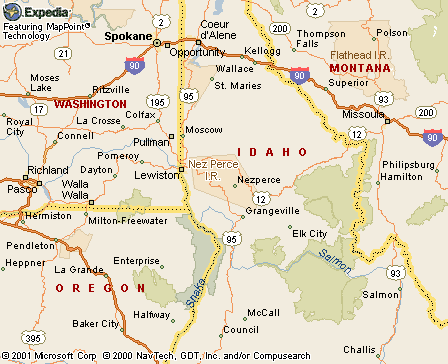|
LEWISTON -- Indian Agent James O´ Neill was trying to
dodge the usual bureaucratic hoops and hang on to an increasingly
shaky peace in Lapwai 135 years ago.
"The Indians (Nez Perce) are divided among themselves
and the non- treaty side are using this argument, that the government
will take their own time for fulfilling the stipulations of the
new treaty as they have the one of June 1855 and they say possibly
never pay them," he wrote to his superiors.
"They cannot or will not understand why, when their money
is ready for them, that they cannot have the benefit of it, and
I sincerely think that to continue putting them off and paying
them in promises will result in serious difficulty."
O´Neill´s letter is one of the many documents
reproduced in one of several new publications by the University
of Idaho Library compiling information about the 1867 Nez Perce
Treaty Council.
It and other publications were discussed recently at the Nez
Perce National Historical Park at Spalding by a panel of historians
and tribal elders.
"We´re very interested in any kind of documentation
of Nez Perce history," said Diane Mallickan, a park ranger
at Spalding and a tribal member.
The documents make rare material, in some cases so old it
is literally falling apart, available to the general public for
the first time.
"It will have an effect on the way historians write about
the Nez Perce," Mallickan said.
The papers trace the history of the region from 1829, when
fur trappers were the only whites in the area, to 1911, when Starr
Maxwell collected testimonies of tribal members in "Memorial
of the Nez Perce Indians," which became part of the U.S.
Congressional Record when Idaho Sen. William Borah presented it
to the Senate in 1911.
Between the two is the "The 1867 Nez Perce Treaty Council,"
edited and transcribed from the original documents by Donna Smith
at the university. It details not only government correspondence,
but contains a verbatim manuscript of a tribal council convened
to discuss the treaty.
The documents provide a rare glimpse into the issues that
led to the Nez Perce War of 1877. Idaho Territory Governor David
Ballard came to Lapwai in June 1867 to announce that the Treaty
of 1863 was law after four years.
"Many wrongs have been perpetrated upon you, by bad white
men, who have come upon your reservation, and by selling whiskey
and practicing other wickednesses," he said.
He realized the new reservation was greatly reduced. But Ballard
promised the government would fulfill its agreements in the new
treaty, "placing you in a position of happiness, competency
and independence."
"Let me warn you, my friends, against evil advice, either
from bad white men, or Indians, it will lead you to destruction,"
Ballard said.
Special Indian Agent George C. Hough was left in Lapwai after
Ballard went to speak with the Nez Perce, and recorded the council
proceedings.
"I see the river (Clearwater) as it winds along here
and look at the reserve as including the south fork as being the
only country upon which to make a settlement. That being the case,
I feel frightened," said Chief Lawyer. "I see a great
many places occupied by the whites."
Hough replied, "Every single place on this reservation
that is occupied by a white man, he will be driven off from."
He later wrote to the commissioner of Indian Affairs in Washington
D.C., that Lawyer, "a man of no little intelligence, a little
education and a consummate diplomatist," told him that "his
patience is getting worn out."
Starr Maxwell's memorial documents the effects the 1887 Allotment
Act, which divided reservations among tribal members, replacing
the traditional practice of treating the reservation as communal
property.
The act lead the way for the settling of reservation land
by whites and led to abuse by local agents, both Indian and non-Indian,
who were granted control of the program.
Maxwell, half white, half Nez Perce, began collecting testimonies
of these abuses, eventually compiling 128 of them.
"He used his legal ability to seek meaningful relief
while calling public attention to an intolerable situation,"
wrote Mallickan in the introduction to the publication of Maxwell´s
memorial.
Mallickan also helped direct a group of tribal elders in a
project aimed at identifying some of the chiefs and others in
the publications. That work will be published in the spring.
The recent publications enrich the material available not
only to researchers, but the public as a whole, Mallickan said.
|

